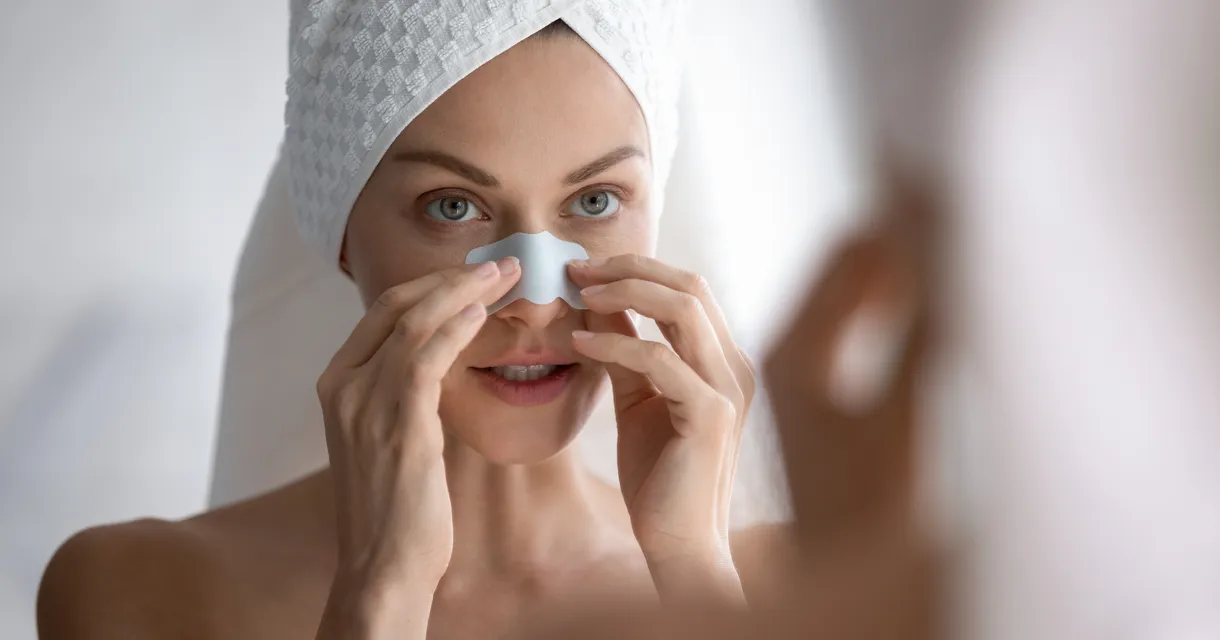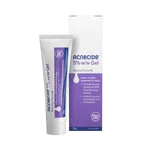Blackheads are an issue that most people have been affected by at one time or another. They look like small black dots, usually found on the face, predominantly across the nose. Find out what blackheads are, how to get rid of blackheads and how to prevent them from coming back.
What are Blackheads?
Blackheads occur when the pores become clogged with dead skin cells and/or excess oil, otherwise known as sebum. Blackheads are open at the surface and exposed to the air, unlike whiteheads which are under the skin. Whilst most people think that the dark colour comes from dirt trapped in the pores, it is actually due to oxidation from the exposure.
Blackheads can be extremely stubborn. Whilst they can go away on their own, some may take months or even years to clear. There are however steps that you can take to get rid of blackheads more quickly and prevent them from coming back in the future.
How to Remove Blackheads
When removing blackheads you have to be careful not to damage the skin. There may be temptation to squeeze the blackhead, but this can cause hyperpigmentation or even scarring.
So, how should you get rid of blackheads? Check out our 15 tips for removing blackheads from your skin without causing damage.
-
Wash Your Face Twice a Day
You should make sure you are effectively cleansing your face twice a day, as well as after exercise. When washing your face, ensure you use a gentle cleanser, such as the MooGoo Creamy Hydrating Cleanser. It is gentle on the skin and doesn’t use any harsh chemicals. Harsh soaps and face washes can strip moisture from the face causing your skin to dry out. The body then begins to produce excess oil to counteract this, which can result in clogged pores and blackheads. Cleansers that contain salicylic acid are particularly good for blackheads as it breaks down the sebum and dead skin cells that are renowned for causing blackheads. Explore our range of face washes and cleansers. -
Exfoliate Regularly
Exfoliation is key to removing blackheads. Exfoliating the skin helps to remove dead skin cells and excess oil, as well as helping to unclog pores. Face scrubs such as Clean and Clear’s Blackhead Clearing Scrub can be used to remove blackheads. However, you should be careful not to over-exfoliate when using scrubs, as this can damage the skin, causing microtears. More recently, chemical exfoliators have become more popular. Chemical exfoliators use products such as glycolic acid or salicylic acid to remove the top layer of the skin. This leaves behind softer skin, helps to unclog pores and reduces the likelihood of more blackheads forming as dead skin cells have been removed. Check the product directions for how often you should exfoliate; the average tends to be a couple of times a week. Explore our range of exfoliants. -
Steam Your Face
Before making any attempt to extract blackheads, you may want to steam your face. The heat from steaming your face helps your pores to open, making it easier for blackheads to be removed. You should moisturise your skin after steaming; this helps the skin retain the heat, making the blackhead extraction easier. -
Use Extraction Tools
If you are going to attempt to extract blackheads on your own, you should never use your fingers or nails! Extracting blackheads without using the proper tools can cause damage to your skin, make blackheads worse and could even result in scarring. If you are removing blackheads using an extraction tool, apply light, even pressure to the area surrounding the blackhead. If it does not begin to give, you should not force it. Simply wait a few days and try again. Removing deep blackheads can be difficult and is better left to the professionals. -
Use Pore Strips
Pore strips are somewhat controversial when it comes to blackheads. Whilst they technically can help you to get rid of blackheads, they can also remove things that are important to your skin. Pore strips contain ingredients that when mixed with water form an adhesive. They are placed across the nose and left to dry. When removed, blackheads, hair follicles, dirt and oil also come with it. These should however be avoided where possible as they are not good for your skin. -
Moisturise
If blackheads are caused by excess oil, you may think that applying moisturiser to your skin sounds counterproductive, but this is not the case. Moisturiser can actually help to balance your skin's natural oils. If the skin becomes dry, the body produces excess oil in order to rectify this, which can result in blackheads forming. By ensuring your skin retains moisture you can stop your body from producing excess oil and reduce the likelihood of blackheads forming. MooGoo’s Cover Up Buttercup moisturiser and SPF contains natural ingredients that are kind to skin, helping to keep it hydrated and protected from the skin. Explore our full range of moisturisers. -
Use Topical Retinoids
Retinoids increase skin cell turnover, helping to remove dead skin cells. As blackheads are often caused by dead skin cells clogging the pores, using a topical retinoid can help to remove and prevent blackheads forming in the future. Topical retinoids can be bought over the counter in your local pharmacy or can be prescribed from your GP. Pregnant women should not use retinol products, however. If you are pregnant, speak to your doctor or a pharmacist - they will be able to offer safe alternatives. -
Apply Stable Vitamin C
Vitamin C is an antioxidant. Applying vitamin C to your skin can therefore help to prevent the debris in clogged pores from oxidising. You need to make sure that you use stable vitamin C, otherwise, it can actually cause increased oxidation resulting in more blackheads. -
Try a Skin Brush
Skin brushes are an alternative way to exfoliate the skin. Skin brushes help to remove dead skin cells and unclog pores when used with a gentle cleanser. They are not recommended for use by those with sensitive skin and should only be used occasionally to prevent the skin from becoming damaged. -
Use a Clay Mask
Clay is renowned in the beauty world for drawing out toxins from the skin and helping to balance the skin's natural oil levels. By using a clay mask a couple of times a week, you can help to maintain a good oil balance, unclog pores and prevent future blackheads. -
Use a Charcoal Mask
Charcoal masks are also an effective way of removing blackheads. Activated charcoal is a detoxifier, helping to draw toxins out of the skin, unclogging pores to get rid of blackheads. -
Remove or Change Your Makeup
Makeup is one of the biggest culprits when it comes to clogged pores. You should ensure that you remove any makeup thoroughly before bed to stop your pores from becoming clogged. Use products such as Covermark’s Removing Cream or Simple’s Kind to Eye Makeup Remover, to ensure all makeup has been fully removed. You should also wash your face with a gentle cleanser. It may also be worth switching out some of our makeup products for others. Things such as foundation can be very heavy on your skin. Try a lighter coverage foundation or a tinted moisturiser instead. Some makeup products even contain anti-blemish ingredients to help prevent clogging. -
Use Non-comedogenic Products
Non-comedogenic products are products that will not cause comedones or clogged pores. Look for skincare and makeup products that state they are non-comedogenic to help prevent blackheads. -
Try a Chemical Peel
If you have tried to get rid of blackheads relentlessly and have had no luck, consider visiting a professional to get a chemical peel. Although not specifically designed to get rid of blackheads, chemical peels remove the top layer of skin, removing dead skin cells and other debris, helping to shrink pores. -
Visit a Dermatologist
If you are seeing no improvement in your blackheads after trying the above methods, or if your blackheads are particularly deep and hard to remove, it is time to visit a dermatologist. Dermatologists are able to offer advice and product recommendations for removing and preventing blackheads, as well as performing professional blackhead extraction treatments.
How to Prevent Blackheads
Once you have managed to remove blackheads, you don’t want all that hard work to go to waste. Take steps to look after your skin and prevent future blackheads.
- Create a good skincare routine and stick to it - maintaining a good skincare routine is half the battle. Ensuring you are cleansing and exfoliating your face regularly helps to prevent a build-up of oil and dirt that can clog pores. Moisturising also helps to avoid excess oil being produced by the skin.
- Pay attention to ingredients - make sure you look for non-comedogenic products to stop your pores becoming clogged by your makeup or skincare products.
- Wash your hands and hair regularly - your hands and hair both regularly touch your face. By ensuring these are clean you can help to prevent oil and dirt transfer that can result in clogged pores.
- Ensure bedding is clean - make sure you are changing your pillowcases and bedding at least once a week. As with hair and your hands, dirt and debris can be transferred to your skin from bedding resulting in blackheads.
- Listen to your skin - avoid anything that dries out your skin as this causes excess sebum to be produced, which can lead to blackheads. If a certain product dries out your skin, try something else!
Check out our skincare products to find the perfect products to help you get rid of blackheads. Still struggling with your skin? Get in touch or visit one of our local branches for advice.

